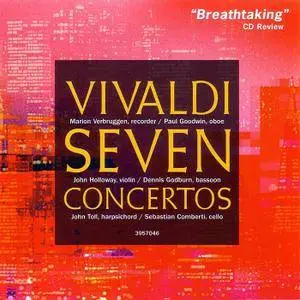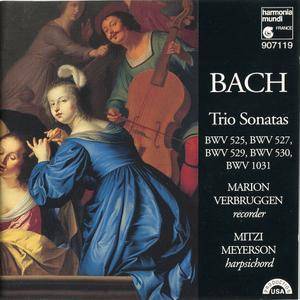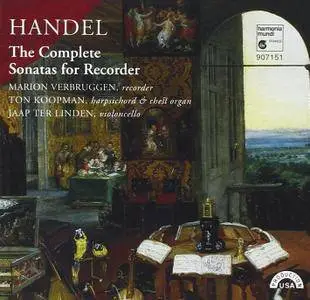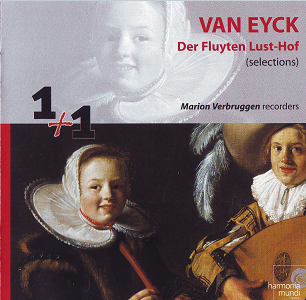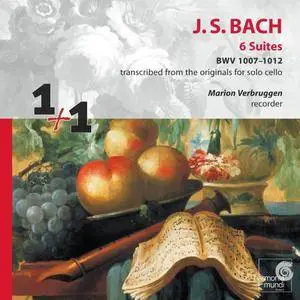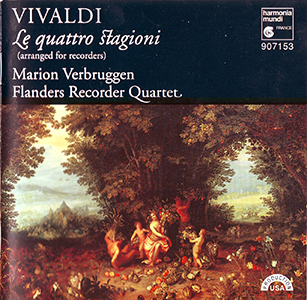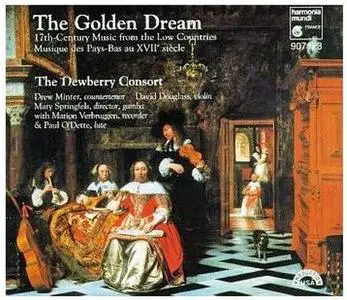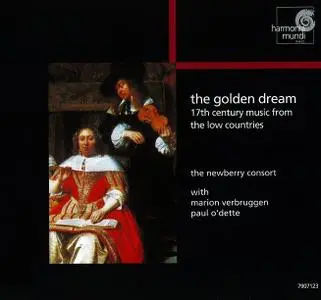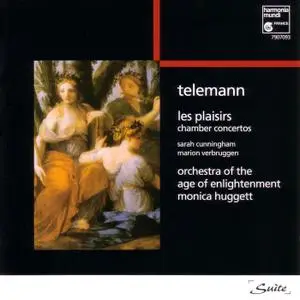Marion Verbruggen
Marion Verbruggen - Vivaldi: Seven Concertos (2001) Music
Posted by tirexiss at April 24, 2023
Marion Verbruggen - Vivaldi: Seven Concertos (2001)
EAC | FLAC (image+.cue, log) | Covers Included | 01:04:11 | 406 MB
Genre: Classical | Label: Harmonia Mundi | Catalog: HCX3957046
EAC | FLAC (image+.cue, log) | Covers Included | 01:04:11 | 406 MB
Genre: Classical | Label: Harmonia Mundi | Catalog: HCX3957046
Marion Verbruggen is known for her magnetic performances, which demonstrate not only her skills as a recorder player, but also her understanding of the repertoire. She makes playing the recorder look effortless, switching easily between the tenor-, alto-, and soprano-voiced instruments during any recital or concert. She can also play florid ornaments, crisp accents, and smoothly liquid passages while maintaining ideal breath control. Verbruggen adds subtlety of shading and vibrancy to her music, having what one reviewer called a "flip sense of articulation."
Marion Verbruggen, Mitzi Meyerson - Johann Sebastian Bach: Trio Sonatas (1994) Music
Posted by Designol at June 5, 2025
Marion Verbruggen, Mitzi Meyerson - Johann Sebastian Bach: Trio Sonatas (1994)
EAC | FLAC | Image (Cue&Log) ~ 329 Mb | Mp3 (CBR320) ~ 144 Mb | Scans ~ 73 Mb
Genre: Classical | Label: Harmonia Mundi | # HMU 907119 | Time: 01:02:59
EAC | FLAC | Image (Cue&Log) ~ 329 Mb | Mp3 (CBR320) ~ 144 Mb | Scans ~ 73 Mb
Genre: Classical | Label: Harmonia Mundi | # HMU 907119 | Time: 01:02:59
This is a delightful, inventive, witty, charming, enchanting, inspiring disc. In the Verbruggen disc, only four of the six sonatas appear together, plus one other trio sonata (BWV 1031). Perhaps Ms. Verbruggen thought that BWV 526 and 528 did not translate well to the recorder. In any event, the recorder and the harpsichord are outstanding here, as is the recording quality. Highest recommendation.
Marion Verbruggen, Ton Koopman, Jaap Ter Linden - George Frideric Handel: The Complete Sonatas for Recorder (1995) Music
Posted by Designol at May 29, 2025
George Frideric Handel: The Complete Sonatas for Recorder (1995)
Marion Verbruggen, recorder; Ton Koopman, harpsichord; Jaap Ter Linden, violoncello
EAC | FLAC | Image (Cue&Log) ~ 282 Mb | Mp3 (CBR320) ~ 133 Mb | Scans ~ 41 Mb
Genre: Classical | Label: Harmonia Mundi | # HMU 907151 | Time: 00:57:38
Marion Verbruggen, recorder; Ton Koopman, harpsichord; Jaap Ter Linden, violoncello
EAC | FLAC | Image (Cue&Log) ~ 282 Mb | Mp3 (CBR320) ~ 133 Mb | Scans ~ 41 Mb
Genre: Classical | Label: Harmonia Mundi | # HMU 907151 | Time: 00:57:38
If only for his melodic genius, Handel would have been forever acknowledged as one of history's greatest composers. These delightful sonatas for recorder provide abundant evidence to support that claim, and Marion Verbruggen's warm, resonant recorder and brilliant flute prove the perfect partners for bringing these rarely heard pieces to life.
Marion Verbruggen - Van Eyck - Der Fluyten Lust-Hof (2CDs) Music
Posted by kovacsistvan at June 3, 2010
Marion Verbruggen - Jacob Van Eyck: Der Fluyten Lust-Hof (The Flute's Garden of Delights)
Selections from Volume 1 (1649) & Volume 2 (1654)
Harmonia Mundi | FLAC + CUE + LOG | covers & booklet | TT: 2hr 18:19 | RAR 534 Mb
Classical, Baroque | HMX2907350.51| 1993 | RS
Selections from Volume 1 (1649) & Volume 2 (1654)
Harmonia Mundi | FLAC + CUE + LOG | covers & booklet | TT: 2hr 18:19 | RAR 534 Mb
Classical, Baroque | HMX2907350.51| 1993 | RS
Der Fluyten Lust-Hof (The Flute's Garden of Delights) contains almost all Van Eyck's work. Volume I, which was essentially a reprint of an earlier book, Euterpe (1644), appeared in 1649; Volume II was published in 1654. This printed collection of 17th century European popular tunes contains in its two volumes some 150 pieces or sets of variations based on 120 tunes.
J.S. Bach - 6 Suites BWV 1007-1012 transcribed from the originals for solo cello (Marion Verbruggen) - 2006 Music
Posted by Aregak at May 9, 2018
J.S. Bach - 6 Suites BWV 1007-1012 transcribed from the originals for solo cello (Marion Verbruggen) - 2006
WEB FLAC (tracks, cover, logs) | 02:09:13 | 589.40 MB
Classical | Harmonia Mundi
WEB FLAC (tracks, cover, logs) | 02:09:13 | 589.40 MB
Classical | Harmonia Mundi
Much of Bach's music is abstract enough that it can easily be arranged for new instrumental combinations, and often was by the composer himself. The music for unaccompanied violin and for unaccompanied cello forms an exceptional case; the sonatas and partitas for solo violin were part of a long tradition of virtuoso violin music to which Bach was making a conscious contribution, and the six suites for solo cello were written as extensions of the ideas in the violin pieces. Transferring the cello suites to a solo recorder, which is incapable of executing many details of the cello scores, is thus something Bach probably wouldn't have countenanced. ..
Marion Verbruggen & Flanders Recorder Quartet - Vivaldi - Le quattro stagioni Music
Posted by kovacsistvan at June 4, 2010
Marion Verbruggen & Flanders Recorder Quartet - Vivaldi: Le quattro stagioni (The Four Seasons / Les Quatre Saisons / Die vier Jahreszeiten)
Arranged for five recorders by / adaptés pour cinq flûtes à bec par / für fünf Blockflöten bearbeitet von Joris van Goethem
Harmonia Mundi France | FLAC + CUE + LOG | covers & booklet | TT: 38:37 | RAR 139 Mb
Classical, Baroque | HMU907153 | 1996 | RS
Arranged for five recorders by / adaptés pour cinq flûtes à bec par / für fünf Blockflöten bearbeitet von Joris van Goethem
Harmonia Mundi France | FLAC + CUE + LOG | covers & booklet | TT: 38:37 | RAR 139 Mb
Classical, Baroque | HMU907153 | 1996 | RS
"We became 'infected' with the desire to arrange The Four Seasons for our own instrument. In order to present Vivaldi's 'famous four' in a new light, we use the whole range of recorders from sopranino to contrabass in F. Our 'cello', a bass recorder in C. by F. von Huene, was specially built for this project." - Joris van Goethem
The Golden Dream - Paul O'Dette Music
Posted by rotro at May 23, 2007
The Golden Dream - Paul O'Dette
Classical, 17th Century Music | APE,CUE | 260 Mb | Label: Harmonia Mundi | Length: 1 Hours 6 Mins
Release Date: 05/11/1999
Classical, 17th Century Music | APE,CUE | 260 Mb | Label: Harmonia Mundi | Length: 1 Hours 6 Mins
Release Date: 05/11/1999
The Newberry Consort - The Golden Dream: 17th Century Music from the Low Countries(1999) Music
Posted by ArlegZ at Oct. 27, 2018
The Newberry Consort - The Golden Dream: 17th Century Music from the Low Countries(1999)
EAC | FLAC | Image (Cue & Log) ~ 280 Mb | Total time: 66:29 | Scans included
Classical | Label: Harmonia Mundi | # HMT 7907123 | Recorded: 1993
EAC | FLAC | Image (Cue & Log) ~ 280 Mb | Total time: 66:29 | Scans included
Classical | Label: Harmonia Mundi | # HMT 7907123 | Recorded: 1993
Every piece on this Newberry release is temperate and balanced, just as the musical culture and domestic society were in the countries now known as the Netherlands and Belgium.
While a certain blandness creeps into the instrumental selections, pieces by Nicholas a Kempis, Tarquinio Merula and John Coperario reveal a sharper, more personal profile. Most striking are the vocal-instrumental esoterica–the brightly serene "Je veux mon doux Sauveur" by an anonymous composer and the richly embellished "Avertisti faciem" by Constantijn Huygens, both works sweetly sung by the remarkable countertenor Drew Minter.
Sarah Cuninngham, Orchestra of the Age of Enlightenment, Monica Hugget - Telemann: Les Plaisirs - Chamber Concertos (1997) Music
Posted by tirexiss at April 13, 2021
Sarah Cuninngham, Orchestra of the Age of Enlightenment, Monica Hugget - Telemann: Les Plaisirs - Chamber Concertos (1997)
WEB | FLAC (tracks) - 353 MB | MP3 (CBR 320 kbps) - 187 MB | 73:39
Genre: Classical | Label: Harmonia Mundi
WEB | FLAC (tracks) - 353 MB | MP3 (CBR 320 kbps) - 187 MB | 73:39
Genre: Classical | Label: Harmonia Mundi
This cd contains one of the best performances of Telemann's well-known A Minor Suite for recorder and strings. Sarah Cunningham is a fine recorder player, and Monica Hugget plays first violin and directs the Orchestra of the Age of Enlightenment, who play on period instruments. The strings play with very little or no vibratto, which might sound a bit dry to some listeners, but the elegance and precision of this band will win over many others. The A Minor Concerto for recorder is also given an enjoyable performance, but the remaining pieces, a Suite in D for Viola da gamba, and a Sinfonia in F for recorder and gamba are less pleasing, mainly because the gamba playing of Marion Verbruggen is somewhat less than exciting.
Project Harmonia Mundi - Part 4 Music
Posted by Flush at Sept. 26, 2007
